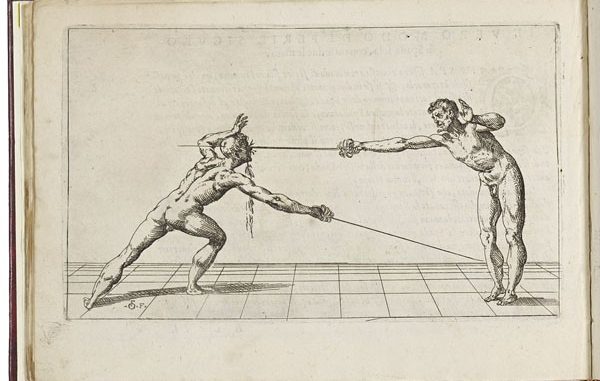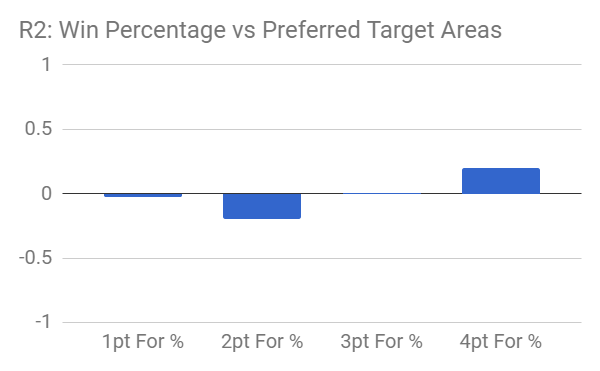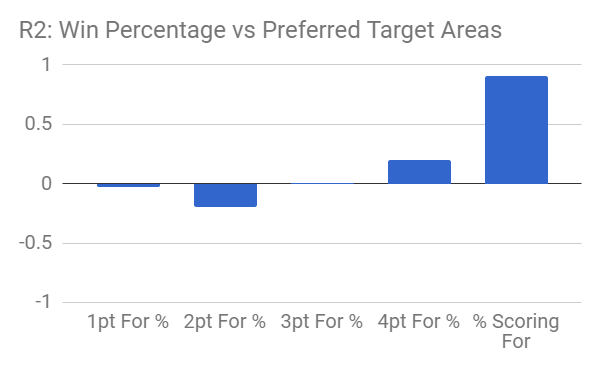
When designing a tournament ruleset, one of the most identifiable aspects is how much each target is worth. Most seem to balance the following considerations:
- The more you specify point values for different targets/actions, the more you can influence fighter behavior.
- The more you specify point values for different targets/actions, the more difficult it is for judges to make accurate calls.
Most events arrive at a spread of somewhere between 2-4 different targets, with the high value being between 200-400% of the low value.
The logic is simple:
- If one can hit the higher value targets, they will have an advantage over their opponent and be more likely to win the match.
- This causes fighters to pursue the higher value targets, which event organizers hope leads to fighting more in line with the style they are trying to create.
(The flipside is that fighters may also try to adopt strategies of being less defensive of lower value targets. As we ideally want competitors to try not to take any hits, this can be potentially problematic. But that is an investigation for another day.)
Now, is it true that hitting higher value targets gives you an advantage?
(All of these statistics were compiled from deductive afterblow rulesets. Point values from 1-4 and an afterblow reducing the score by one. It is not speculated what the conclusions would be under different conditions, such as Full Afterblow rules.)
An Introduction to Correlation Coefficients
TL;DR version: The further the value is from 0, the more things appear to be related. -1 and 1 mean that they appear to be perfectly linked, 0 means that they don’t appear to be related at all. The rest of this section will try to get a little more appreciation for what the number means, so if you don’t care just skip to the next section.
A correlation coefficient (R2) is used to compare two things and see if they appear to be related.
Positive Correlation Coefficients
For instance, if you were to take a measurement of the temperature and how much a given quantity of mercury expanded, you would see that they are always related. Increase the temperature by 1 degree and the mercury would expand by a certain amount. Increase the temperature by 2 degrees and the mercury would expand by exactly double.
In the mercury example, the R2 would be exactly 1. But let’s consider something like how much bacon you eat a day and how fat you are. We know that there is going to be a trend between being eating more bacon and being more fat. But not every person that eats more bacon than someone else will be fatter. In this case you would see a positive correlation, but the value would be less than 1. The more significant the relation, the higher the value.
Negative Correlation Coefficients
The exact same principle works for a negative correlation coefficient. If you were to say, compare how much people exercise with how fat they are, you would see the relationship is negative: people who exercise more are less likely to be fat. This is a negative correlation, they are related, but an increase in one leads to a decrease in the other.
Much like the positive version, this goes between 0 (completely unrelated) and -1, (completely related).
Zero Correlation Coefficients
If a correlation is 0 it means there is no apparent connection between the two things. Imagine comparing the number of times you tied your shoes on any given day to the performance of the Hong Kong stock exchanges. These things are completely unrelated.
Tournament Data
I examined the stats of all West Coast longsword fighters who have more than 100 exchanges recorded* (72 fighters). The preferred target areas for each fighter were then determined by calculating the percentage of time they were awarded each point value. The following data was produced by correlating target preferences to win percentage.

What we can see, first of all, is that there is an astonishingly small correlation between target values and win percentage. There is only a very marginal preference for people landing a lot of 4 point shots and winning a lot of matches, and given the small sample size I would not consider it extremely significant.
Hit Percentages
Now I’ll add another correlation to the graph.

That big bar at the end? That’s the correlation between hitting your opponent more than they hit you. It shouldn’t be a big surprise that there is a strong correlation between hitting your opponent more than they hit you and winning the match. (And if there isn’t, you should probably seriously re-examine your ruleset.)
What is interesting is how much more important it is compared to how many points you are getting for the hits you are scoring.
This can be expressed a little more intuitively. This suggests that if you took every tournament fight you ever fought and made every hit worth 1 point, you would still have the same number of wins and losses over your career. Certainly there would be a few fights that you had won because of hitting high value targets that you would now have lost. But for every one of those you tend to get a win that you wouldn’t have gotten otherwise.
In summary, over the long term it looks like having targets weighted differently has little outcome overall.
Eliminate All Weighting?
Personally? No, I wouldn’t recommend going that far.
In my mind, the most important aspect of the weighting is the incentivisation of certain actions. While overall it may not have much of an effect on the results, it can still have a profound effect on the behavior of the fighters. To use some anecdotal evidence, a quote from an individual I was analyzing this data with:
“Even if the overall effect isn’t significant, I still really like the weighting. It makes me feel that even if I am down I still have a chance to come back if I can land the high value techniques. And even if I am up, I have to be very on guard and afraid of my opponent.”
This is a great mindset to promote in our competitors. Though I don’t have any data (yet…) to draw conclusions on mindset, I feel that his would be shared by many. So we don’t have to upend all the rulesets we’ve created just yet.
But make sure you realize that “my ruleset rewards the people who can do <x>” is probably not actually all that true, though the jury is still out on “my ruleset encourages people to do <x>”.
Full Data
For those of you that care. 😉
*Data Taken From: PNW 2014,2015; SoCal Swordfight 2015-2018; Combat Con 2015-2017, Rose City Classic 2016-2017
| R2 Values | Win % | 1pt For % | 2pt For % | 3pt For % |
| Win % | ||||
| 1pt For % | -0.0237 | |||
| 2pt For % | -0.2004 | -0.4649 | ||
| 3pt For % | 0.0021 | -0.357 | -0.1984 | |
| 4pt For % | 0.1967 | -0.0277 | -0.5352 | -0.339 |
| R2 Values | Win % | % Clean Hits For | % Scoring For | % Double Hits | % Afterblows Landed |
| Win % | |||||
| % Clean Hits For | 0.8569 | ||||
| % Scoring For | 0.9078 | 0.9504 | |||
| % Double Hits | -0.0234 | -0.1987 | -0.1505 | ||
| % Afterblows Landed | 0.1859 | 0.1585 | 0.1354 | 0.1501 | |
| % Afterblows Hit With | -0.1279 | -0.4485 | -0.1597 | 0.221 | -0.1129 |
If you are nerdy enough to want to pore through this kind of thing, drop me a line! I’m always looking for analytically minded people to collaborate with, and expand the size of data sets the community has access to.

